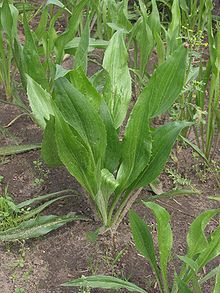Spanish salsify
| Black salsify | |
|---|---|
 |
|
| Scientific classification | |
| Kingdom: | Plantae |
| (unranked): | Angiosperms |
| (unranked): | Eudicots |
| (unranked): | Asterids |
| Order: | Asterales |
| Family: | Asteraceae |
| Genus: | Scorzonera |
| Species: | S. hispanica |
| Binomial name | |
|
Scorzonera hispanica L. |
|
Scorzonera hispanica, black salsify or Spanish salsify, also known as black oyster plant, serpent root, viper's herb, viper's grass or simply scorzonera, is a perennial member of the genus Scorzonera in the sunflower family (Asteraceae), cultivated as a root vegetable in the same way as salsify (Tragopogon porrifolius), also in the sunflower family.
The scorzonera sweet is a crystallized dessert made from scorzonera in Évora, Alentejo, Portugal. It is listed on the Ark of Taste.
The black salsify plant has heads of yellow ray flowers. The thin black taproot grows up to one meter long and up to 2 centimetres (0.8 in) in diameter. It has a black skin with white internal flesh.
Black salsify is native to Southern Europe and the Near East. As is indicated by its binomial name, it is generally thought to have spread to the rest of Europe from Spain, but the first mention of the vegetable by a Western writer came from Leonhard Rudolf, who reported seeing scorzonera at the market of Aleppo in Syria, in 1575. Although it is often claimed that the name of the genus Scorzonera probably derives from the Old French word scorzon, meaning snake (or "adder" to be exact), it is more likely that the name is derived from the Italian "scorza negra" meaning "black bark"/"black peel" and obviously indicating the dark brown to black skin of the root. The Celtic and Germanic peoples are believed to have eaten the black salsify, which was considered efficacious against the bubonic plague and snake bites until the 16th century. The plant was being cultivated as a vegetable in Italy and France by 1660 and, soon after, the Belgians were growing vast fields of it.
...
Wikipedia
